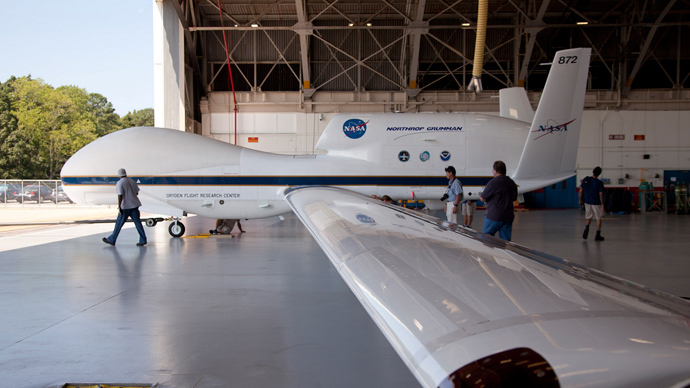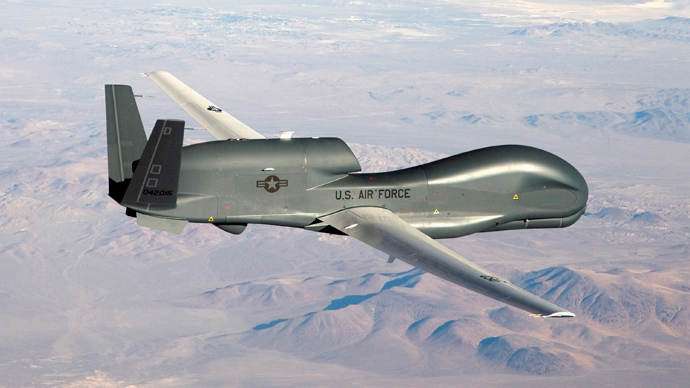Despite needed cuts to big ticket US defense programs, an investigation into Northrop Grumman’s lobbying efforts reveals the military contractor kept its costly Global Hawk drone flying despite the Pentagon’s own attempt to kill the project.
Though the proliferation of unmanned aerial vehicles into use by
America’s military is seemingly unstoppable, at least one drone
project, the $223-million Global Hawk, was determined to be
underperforming and unnecessary in a report put together by top
officials in 2011.
“The Block 30 [version of
Global Hawk] is not operationally effective,” the
Pentagon’s head testing official declared in a May 2011 report
about the drones, which were being assembled by Northrop in
Palmdale, California. According to The Center for Public
Integrity (CPI), neither that report nor efforts by both the
White House and top Army officials managed to thwart the drone
program.
It was projected that cancellation of new orders of the Global
Hawk, a lumbering unmanned reconnaissance aircraft with the
wingspan of a tanker, would save the government $2.5 billion over
five years. Those cuts would have also placed already built and
deployed Global Hawks into storage in favor of America’s
ubiquitous spy plane, the U-2, which could accommodate more
sensors and fly higher than the drone.
In February of 2012 the chairman of the Joint Chiefs of Staff,
Army Gen. Martin Dempsey, told the House Armed Services Committee
in that the Global Hawk had “fundamentally priced itself out of our
ability to afford it.” Dempsey’s statements were further
pushed by the White House, which twice told Congress that it
“strongly” objected to
additional Global Hawk orders.
Despite the determination that the Global Hawk, the largest drone
currently serving with US forces, was to be killed, the lobbying
effort mounted by Northrop proved unstoppable.

According to Gordon Adams, a former senior White House budget official for national security, halting the momentum on a large defense contractor project is easier said than done.
“Killing a major program, in
production, is rather like vampire-killing,” Adams told
CPI. “You have to drive a
silver stake through its heart to make sure it is dead.”
Adams described the defense contractor’s response as “entirely predictable” and highly
effective.
“Hire the right people, target
the right people, contribute to the right people, then link them
together with subcontractors and go for the gold,” says
Adams.
Adams tells CPI that the Global Hawk fiasco mimics many other
defense contractor campaigns to sustain embattled programs.
“It eked out more F-22
[fighters] than the Air Force wanted. It extended the C-17
[transport] production line by several years as Congress ordered
up 10 more aircraft beyond what the Air Force needed,”
Adams points out.
A congressional source familiar with the Global Hawk program
tells CPI that, ironically, the drone proved to be problematic
and ultimately unneeded to the US Air Force because it was
developed and built before combat commanders even specified their
needs.
As a result of Northrop’s rush to produce the large drones, once
in service, problems that required additional testing and
modifications meant that the cost for a single Global Hawk
increased by 150 per cent, from $88 million in 2001 to $223
million in 2012, according to the Government Accountability
Office.
Hints that the Global Hawk program was headed for the chopping
block prompted Northrop to create a 'Support Global Hawk' website
in late 2011. That website listed all of the suppliers involved,
their congressional districts as well as the lawmakers
representing them. The defense contractor also distributed fliers
throughout Capitol Hill, with maps showing the locations of the
drone’s manufacturing sites, military bases and subcontractors.
According to CPI, another major element of Northrop’s campaign to
keep the Global Hawk alive involved major campaign contributions:
key members of the House Armed Services Committee and a related
subcommittee received a total of $941,000 in contributions
between 2009 and 2012.
Of the 26 lobbyists who fought on behalf of Northrop’s Global
Hawk were three former Republican aides to the House
Appropriations Committee. Part of that team was also Northrop’s
VP for Government Relations, Sid Ashworth, who had served for 14
years as a staff member on the Senate Appropriations Committee.
Ultimately, Northrop’s efforts paid off, and despite efforts by
the Pentagon and the Obama administration to kill the program the
fiscal year 2013 defense authorization bill passed by Congress
will require the Air Force to fly the Block 30 Global Hawks
through 2014, costing $260 million per year. The bill also
stipulates that the US spend as much as $443 million on three
additional Global Hawk drones.

